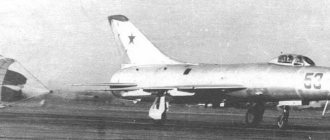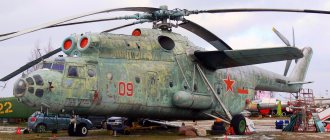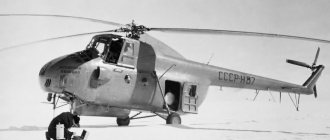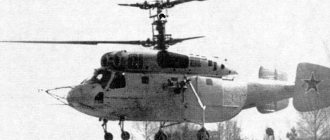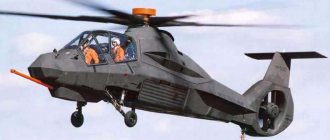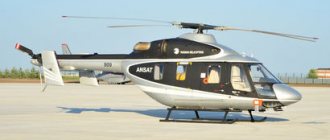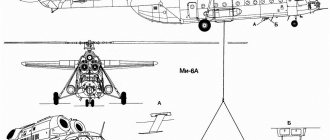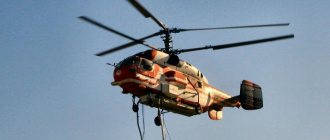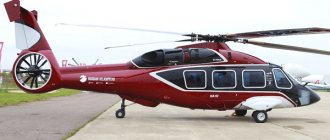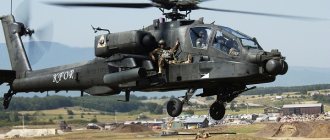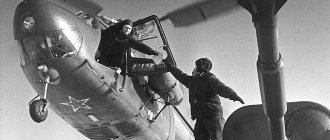Development of the helicopter began in 1947. under the leadership of M.L. Mil, who proposed a project for a light multi-purpose helicopter for military and civilian use. Previously, under the leadership of M.L. Mil at the Central Aerohydrodynamic Institute (TsAGI), a full-scale NSU helicopter installation was designed and built for aerodynamic studies of a full-size main rotor, which was then used for a helicopter designated GM-1.
Mi-1 helicopter - video
Three experimental helicopters were built at the aviation plant in Kiev: the first flight of the first experimental helicopter took place on September 28, 1948. (test pilot M.K. Baikalov), later in 1948-1949. - the remaining two experimental helicopters (test pilots G.A. Tinyakov, V.V. Vinitsky and M.L. Gallai). State tests of the third experimental helicopter began on September 10, 1949, and on February 21, 1950. A resolution was adopted by the Council of Ministers of the USSR on the start of serial production of the Mi-1 (GM-1) helicopter. Serial production began in 1950. at the Moscow Helicopter Plant, and then in a large series from 1952. in Kazan, which marked the beginning of large-scale production of helicopters in our country.
In 1954 Mi-1 helicopters began to be produced in Orenburg and since 1958. In Rostov. In 1957 Production of Mi-1 helicopters began under license in Poland. In total it was in 1950-1960. more than 2,500 helicopters were built, in addition, 300 helicopters were produced in 1957-1960. under license in Poland.
When creating and fine-tuning the Mi-1 helicopter, a number of original technical solutions were used, including a main rotor control system with inertial dampers, subsequently equipped with irreversible hydraulic boosters, the integration of control systems for the general pitch of the main rotor and engine power into a single “step-throttle” system, anti-icing system for main and tail rotor blades and others.
In terms of its flight performance characteristics, the Mi-1 helicopter was close to the famous American Sikorsky S-51 helicopter, created in 1946, and the English Bristol 171 helicopter, created in 1947, however, unlike these helicopters, which were built for a short time in a small series (Sikorsky S -51 in 1947-1951, 379 helicopters were built and Bristol 171 in 1950-1954, 178 helicopters were built) and being “transitional” helicopters that found limited use and were soon replaced by more advanced helicopters, Mi-1 helicopters received the widest practical use in the armed forces and the national economy of our country and in many countries where they were exported, having proven themselves well in operation. The high performance characteristics of the Mi-1 helicopters are evidenced by those installed in 1958-1968. 27 international records, including speed records of 210.535, 196.452 and 141.392 km/h based on 100, 500 and 1000 km, altitude 6700 m and flight range 1654.571 km, as well as 11 women's records.
Therefore, Mi-1 helicopters have remained in operation in many countries to this day; according to data provided in the annual review “Military Aviation of the World”, published in the magazine “Flight International”, as of mid-1995. approximately 150 Mi-1 helicopters were used in the armed forces of countries around the world.
Modifications
Mi-1 - Basic version, designed for a pilot and two passengers.
Mi-1A - This model differed from the Mi-1T, mainly in the presence of electromechanical trimmers instead of spring trimmers, more advanced instrumentation, as well as an on-board unit for installing an additional fuel tank. There was also a training modification, designated Mi-1AU, it was equipped with a periscope observation device and an aerial spotter camera - Mi-1 AKR. The service life of the main parts of the helicopter reached 1000 hours by the end of the 1950s, and by the mid-1960s. - 2000 hours, and after another 10 years reached 3000 hours.
Agricultural Mi-1 - for use in agriculture and forestry for pest control; equipped with two tanks on the sides of the fuselage with a capacity of 250 liters and rods with nozzles for spraying chemicals
Mi-1МНХ (НХ) - Mi-1МНХ is an improved version of the Mi-1. The Mi-1M became the basis for the emergence of a new civilian modification, the Mi-1MNH. It was created in five versions: passenger with a three-seater rear sofa, sanitary with side removable gondolas, postal with hanging containers, ferry with an additional gas tank and agricultural, which, when used for spraying and pollination, was equipped with special side spray tanks and spray bars. The Mi-1MNH entered mass production and operation as the Mi-1НХ and in 1959 received the name “Moskvich”. Since the early 1960s. All Mi-1M and Mi-1NX began to be equipped with uprated AI-26VF engines, as well as all-metal blades and hydraulic boosters in the control system. On June 27, 1960, the Mi-1NX was shown to N.S. Khrushchev. One such helicopter, made in the “luxury” version, was used by the President of Finland.
Sanitary Mi-1 - with two suspended gondolas on the sides of the fuselage for patients, connected to the cabin, and a table for medical equipment in the cabin; built in 1954
Mi-1P - deck-mounted with float landing gear; used in the whaling flotilla "Slava"
Mi-1P - Mi-1P is a variant with floats.
Mi-1T - Mi-1T is a further development of the Mi-1U modification. On the Mi-1T (T - “three-hundred-hour”, this meant that the service life of the main parts of the machine was increased to 300 hours) a newer power plant was installed, an AI-26V engine with a take-off power of 575 hp, the cabin doors were expanded, and a controlled stabilizer and anti-icing system for both propellers. The new experimental model became the model for the 1955 series. Its two-seat training modification was designated Mi-1TU. In 1954, two of these helicopters were re-equipped and sent for operation to the Arctic for deployment on icebreakers, while at the same time work began on creating a version of the Mi-1KR (later Mi-1TKR) artillery spotter, which was put into production in 1956.
Mi-1U - Mi-1U is a training version with dual control capability. Widely used in DOSAAF.
Mi-3 - Mi-3 is the result of a deeper modernization of the Mi-1. It was created by order of the military for medical needs. The Mi-1 differed from the basic version by a new four-bladed main rotor, a more comfortable cabin, the design of the fuselage was also changed, and suspended gondolas were installed on the sides for transporting the sick and wounded.
Military Mi-1MU with four ATGMs of the Phalanx complex, 1961.
Design
The helicopter is made according to a single-rotor design with a tail rotor, one propeller and a tricycle landing gear. Aluminum alloy skinned truss fuselage and a semi-monocoque tail boom with an upwardly angled end boom and a controlled stabilizer. The cockpit accommodates a pilot in the front seat and two passengers in the rear, in the training version with dual controls - a cadet in the front seat and an instructor behind him.
The chassis is tricycle, non-retractable, the main supports are a truss structure, the front support is self-orienting. A safety support is installed at the end of the tail boom. Chassis track 3.29m, chassis base 3.2m.
The main rotor is three-bladed, with hinged blades and friction dampers. The blades are of mixed construction with a steel tubular spar, wooden ribs and stringers and a plywood and canvas skin. The blades have a trapezoidal planform and a NACA 230 profile with variable relative thickness. The latest helicopter models were equipped with all-metal blades, rectangular in plan, with a pressed spar made of aluminum alloy with sections with aluminum honeycomb core glued to it.
The tail rotor is three-bladed, 2.5 m in diameter, pushing, with wooden trapezoidal blades.
The power plant consists of one star-shaped seven-cylinder piston engine AI-26V with a power of 423 kW, installed in a horizontal position and equipped with an angular gearbox and a fan for forced cooling.
The fuel system includes a tank with a capacity of 240 l; it is possible to install an additional external fuel tank with a capacity of 160 l. The transmission consists of a main gearbox with a clutch, an intermediate gearbox and a tail rotor gearbox, shafts and a main rotor brake. The rotation speed of the main rotor shaft is 232 rpm, the tail rotor is 2050 rpm.
The control system is mechanical, with rigid wiring for controlling the collective pitch and a cable system for cyclic control of the pitch of the main rotor blades and the collective pitch of the tail rotor; The control of the stabilizer from the “step-throttle” handle has rigid wiring; the control system includes unloading spring mechanisms. The equipment allows helicopter piloting day and night and in difficult weather conditions. The main and tail rotor blades, as well as the cockpit windshield, have anti-icing alcohol systems.
Interesting Facts
- During the creation of the design of the heavy Mi-6 helicopter with a total take-off weight of more than 40 tons, even heavy foreign analogues of that time had a maximum take-off weight of up to 15 tons.
- For the first time in the Soviet Union, the Mi-6 provided for the transportation of cargo from the outside of the fuselage.
- The Mi-6 became the first helicopter in the USSR with a gas turbine engine.
- In total, the Mi-6 broke 16 world records.
- In 1961, this model managed to overcome the speed threshold of 300 km/h, which was considered inaccessible for helicopters of that time.
- He took part in the liquidation of the Chernobyl disaster in 1986, where he was often confused with the Mi-26, which also took part in the operation. At the present time, many copies are in ruins at radioactive equipment sites, since their further operation is unsafe. One of these is located near the village of Rassokha (Kiev region).
- On October 12, 2012, at the Moscow Aviation Museum, on Khodynskoye Field, a group of vandals sawed the Mi-6 helicopter into small parts.
Performance characteristics of the Mi-1
— First flight: 1948 — Start of use: 1951
Mi-1 crew
- 1 person
Mi-1 capacity
— 2 passengers
Overall dimensions of Mi-1
— Main rotor diameter: 14.346 m — Tail rotor diameter: 2.5 m — Length with rotation. propellers: 17.0 m - Fuselage length: 12.40 m - Height with rotation. screws: 3.3 m
Weight of Mi-1
— Empty weight: 1798 kg — Normal take-off weight: 2296 kg — Maximum take-off weight: 2331 kg
Mi-1 engine
— Engine type: 1 PD Progress AI-26V — Power: 575 hp. With.
Speed Mi-1
— Cruising speed: 130 km/h — Maximum speed: 170 km/h — Climb rate: 318 m/min
Mi-1 flight range
— 370 km
Practical ceiling of Mi-1
— 3000 m
Accidents and disasters
01/3/1984 - Mi-6 crash in Novoagansk. The helicopter was transporting cargo and passengers during an oil exploration expedition. During takeoff, it was unable to gain sufficient altitude and crashed into the ground, after which it turned over on its left side and burned out. 38 out of 75 passengers died; the crew, including 5 people, managed to survive. The most likely cause of the disaster is considered to be overloading of cargo. This modification, when fully loaded with cargo, can take on board no more than 60 passengers, but there were 75 of them.
12/11/1990 – plane crash near the city of Korbin (Brest region, Republic of Belarus). While landing in difficult weather conditions, the crew lost control, as a result of which a critical pitch angle was reached. The helicopter fell to the ground and caught fire. The crew commander and his assistant died at the scene of the disaster. The navigator and on-board mechanic, having received huge areas of bodily burns, were transported to the Korbinsk City Hospital, where they also died a couple of days later.
Mi-6 helicopter. Gallery.
